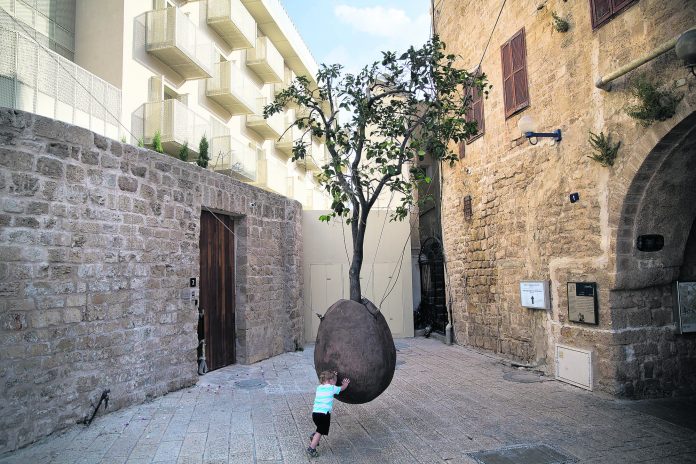
Just south of Tel Aviv’s glass towers and concrete houses are the white stone buildings of Jaffa, the ancient port town.
Jaffa has existed for thousands of years, but today it is one unified city with Tel Aviv, which was founded in 1909. Both Jews and Arabs live in Jaffa, and that’s reflected in the flavors of the neighborhood.
Visitors will find a luxury hotel, the Setai, built out of a Crusader fortress that was later a prison and police station. Trendy cafes, galleries, bars and boutiques line narrow streets, intersecting with Jaffa’s well-known Arab hummus spots and bakeries, along with mosques, churches and synagogues.
In and around Jaffa’s famous flea market, Shuk Hapishpeshim, are streets dotted with cafes. On one of my visits, I sat in an alley and munched on Shaffa Bar’s shakshuka, poached eggs baked in tomato sauce, while chickens clucked on the roof of a building down the street.
Cafe Puaa has comfy, chic but mismatched furniture, and will sell you the plates you eat off (nearly everything is for sale). Its menu is packed with the vegetable dishes that Israeli cuisine is known for. After settling into a couch in the alley in front of the restaurant, I had a deconstructed sabich, a breakfast sandwich of fried eggplant and hard-boiled egg of Iraqi origin that’s a popular Israeli street food. (Try a regular sabich too, at Sabich Hasharon, a small storefront in Tel Aviv that specializes in them.)
The market itself, surrounded by Yefet, Beit Eshel and Yehuda Margoza streets, is a paradise for those itching to debate trash versus treasure. Across several alleys, vendors spread wares on the ground and stack them in stalls. There are antiques, furniture, clothing, trinkets, coins. On Friday mornings and summer Tuesdays, a pop-up market of crafts and jewelry gets added to the mix. In the afternoon, a party erupts in the outdoor bars.
But don’t forget hummus. In Jaffa, you can’t eat enough hummus, the chickpea puree that’s a bedrock meal in Israel.
There’s Ali Caravan’s famous spot on HaDolphin Street, worth waiting on line for. Another crowded hummus disher is Ha’Asli on Yefet Street, cacophonous with families, workers and tourists, all seeking the platters of hummus, labne, kebab and salads delivered to tables minutes after ordering. You can watch the bakers at work at Abulafia, a popular bakery that stacks breads and other treasures in blue tile-lined glass cases by the sidewalk.
Jaffa’s food offerings also stretch beyond the Mediterranean. Inside Tash and Tasha’s romantic, stone-walled interior are delicious dips, dumplings and breads from Georgia (the country, not the U.S. state). Milk, a coffee shop with limited seating, has expensive coffee and pretty pastries.
Those interested in learning how to cook Arab food can also take a class with a local. Myasser Seri has for years been hosting tutorials in her small kitchen. She can put together a multi-course meal for your group to cook, or you can suggest dishes you’d like to try. Among the dishes we made were maqluba, a mound of rice or bulgur and vegetables inverted onto a plate; meatballs cooked in a sauce of tahini and yogurt; the parsley-and-bulgur salad, tabbouleh; and the Arabic dessert knafe. Her version had thin shreds of pastry and nuts cooked in butter, sugar and lemon.
Seri also introduced us to what she called the “Arabic Parmesan”: yogurt that had been dried in the sun to a rock-hard lump. She grated the block into a powder whose sharp, savory tang did indeed recall Parmesan cheese and added it to a salad of fried eggplant and thin-chopped celery. Prices for her lessons vary per person according to group size.
One of Jaffa’s most popular spots for tourists is the old port. Vessels have set sail here since ancient times; it’s even mentioned in the Biblical story of Jonah, referred to as “Joppa,” where Jonah embarked on the journey that led to his fateful encounter with a big fish — or, in some versions of the story, a whale. The port is still used by local fishermen but it also offers seafood restaurants, shops and entertainment.
There’s plenty to eat and to buy in Jaffa. But one of the best things to do there is simply wander and take in the contrasts. Doors set in old stone walls are catnip for Instagrammers; turn the corner, and there’s a block of modern apartment buildings. Galleries abound, but the streets create their own art.q



















